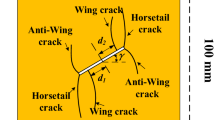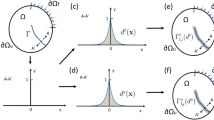Abstract
One of the most successful criteria proposed so far to describe the initiation and propagation of cracks under quasi-static loading in rock-like materials is a stress-based criterion developed by Bobet (Fracture coalescence in rock materials: experimental observations and numerical predictions. Sc. D, Thesis, Massachusetts Institute of Technology, 1997) which is embedded in FROCK, a Displacement Discontinuity code that was developed by the rock mechanics group at MIT. Even though the predictions obtained with this criterion generally correspond to the experimental results, there are cases in which the quasi-static crack propagation results obtained with FROCK are not satisfactory. For this reason, a qualitative study using the Finite Element code, ABAQUS, was conducted to analyze stress-, strain- and energy-based criteria used for modeling crack development. Based on the ABAQUS relative quantitative analysis, it was found that the strain- and stress-based criteria may be more appropriate than the energy-based criterion to model quasi-static crack development. Thus, a strain-based and a normal stress-dependent criterion were implemented in FROCK. The cracking patterns obtained with these proposed criteria were compared with those obtained using Bobet’s original stress-based criterion and with experimental observations made in molded gypsum specimens. The proposed strain-based criterion implemented in FROCK appeared to yield better results than Bobet’s stress-based criterion. The influence of the friction angle (\(\upvarphi \)) on the cracking patterns was studied with the proposed normal stress-dependent criterion and showed that friction angles closer to \(0^{\circ }\) yielded the best results, which may indicate that, at least for the microscale, the critical shear stress at which rock fails does not depend upon the normal stresses applied.
























Similar content being viewed by others
References
Agwai A et al (2011) Predicting crack propagation with peridynamics: a comparative study. Int J Fract 171:65–78
Bobet A (1997) Fracture coalescence in rock materials: experimental observations and numerical predictions. Sc.D, Thesis, Massachusetts Institute of Technology
Bobet A (2000) The initiation of secondary cracks in compression. Eng Fract Mech 66:187–219
Bobet A, Einstein HH (1998a) Numerical modeling of fracture coalescence in a model rock material. Int J Fract 92:221–252
Bobet A, Einstein HH (1998b) Fracture coalescence in rock-type materials under uniaxial and biaxial compression. Int J Rock Mech Min Sci 35(7):863–888
Brooks Z et al (2010) A nanomechanical investigation of the crack tip process zone. In: Proceedings of the 44th U.S. rock mechanics and geomechanics symposium, Chicago, paper 10-301
Chan M (1986) Automatic two-dimensional multi-fracture propagation modeling of brittle solids with particular application to rock. Ph.D. Thesis, Massachusetts Institute of Technology
Chan M et al (1990) Hybridized displacement discontinuity and indirect boundary element method to model fracture propagation. Int J Fract 45:263–282
Erdogan F, Sih GC (1963) On the crack extension in plates under plane loading and transverse shear. J Basic Eng 85:305– 321
Fagerström M, Larsson R (2008) Approaches to dynamic fracture modelling at finite deformations. J Mech Phys Solids 56:613–639
Gonçalves da Silva B (2009) Modeling of crack initiation, propagation and coalescence in rocks. S.M, Thesis, Massachusetts Institute of Technology
Gonçalves da Silva B, Einstein HH (2012) Study of stress and strain fields around a flaw tip in rock. In: Proceedings of the 46th U.S. rock mechanics and geomechanics symposium, Chicago, paper 12-593, 2074–2089
Guo ZK, Kobayashi AS (1995) Dynamic mixed mode fracture of concrete. Int J Solids Struct 32:2591–2607
Ingraffea AR, Heuze FE (1980) Finite element models for rock fracture mechanics. Int J Numer Anal Methods Geomech 4:25–43
Isaksson P, Ståhle P (2002) Prediction of shear crack growth direction under compressive loading and plane strain conditions. Int J Fract 113:175–194
Kobayashi AS (1999) Hybrid method in elastic and elastoplastic fracture mechanics. Opt Lasers Eng 32:299–323
Liu ZL et al (2011) An XFEM/spectral element method for dynamic crack propagation. Int J Fract 169:183–198
Martinez AR (1999) Fracture coalescence in natural rock. MSc Thesis, Massachusetts Institute of Technology
Miller JT (2008) Crack coalescence in granite. S.M, Thesis, Massachusetts Institute of Technology
Morgan S et al (2013) Cracking processes in Barre granite: fracture process zones and crack coalescence. Int J Fract 180:177–204
Ramulu M, Kobayashi AS (1985) Mechanics of crack curving and branching—a dynamic fracture analysis. Int J Fract 27:187–201
Ravi-Chandar K, Knauss WG (1984) An experimental investigation into dynamic fracture: II. Microstructural aspects. Int J Fract 26:65–80
Reyes O (1991) Experimental study and analytical modeling of compressive fracture in brittle materials. Ph.D. Thesis, Massachusetts Institute of Technology
Rice JR (1968) A path independent integral and the approximate analysis of strain concentration by notches and cracks. J Appl Mech 35:379–386
Shen B, Stephansson O (1993) Numerical analysis of mixed mode I and mode II fracture propagation. Int J Rock Mech Min Sci Geomech 30(7):861–867
Sih GC (1974) Strain-energy-density factory applied to mixed mode crack problems. Int J Fract 10(3):305–321
Silling SA, Askari E (2005) A meshfree method based on the peridynamic model of solid mechanics. Comput Struct 83(17–18):1526–1535
Vásárhelyi B, Bobet A (2000) Modeling of crack initiation, propagation and coalescence in uniaxial compression. Rock Mech Rock Eng 33(2):119–139
Wong NY (2008) Crack coalescence in molded gypsum and Carrara marble. Ph.D. Thesis, Massachusetts Institute of Technology
Wong LNY, Einstein HH (2009a) Crack coalescence in molded gypsum and Carrara marble: Part 1—macroscopic observations and interpretation. Rock Mech Rock Eng 42(3):475–511
Wong LNY, Einstein HH (2009b) Crack coalescence in molded gypsum and Carrara marble: Part 2—microscopic observations and interpretation. Rock Mech Rock Eng 42(3):513–545
Xu Y, Yuan H (2011) Applications of normal stress dominated cohesive zone models for mixed-mode crack simulation based on the extended finite element methods. Eng Fract Mech 78:544–558
Yu C, Kobayashi A (1994) Fracture process zone associated with mixed mode fracture of \(\text{ SiC }_{\rm W}/\text{ Al }_{2}O_{3}\). J Non-Cryst Solids 177:26–35
Author information
Authors and Affiliations
Corresponding author
Rights and permissions
About this article
Cite this article
Gonçalves da Silva, B., Einstein, H.H. Modeling of crack initiation, propagation and coalescence in rocks. Int J Fract 182, 167–186 (2013). https://doi.org/10.1007/s10704-013-9866-8
Received:
Accepted:
Published:
Issue Date:
DOI: https://doi.org/10.1007/s10704-013-9866-8




